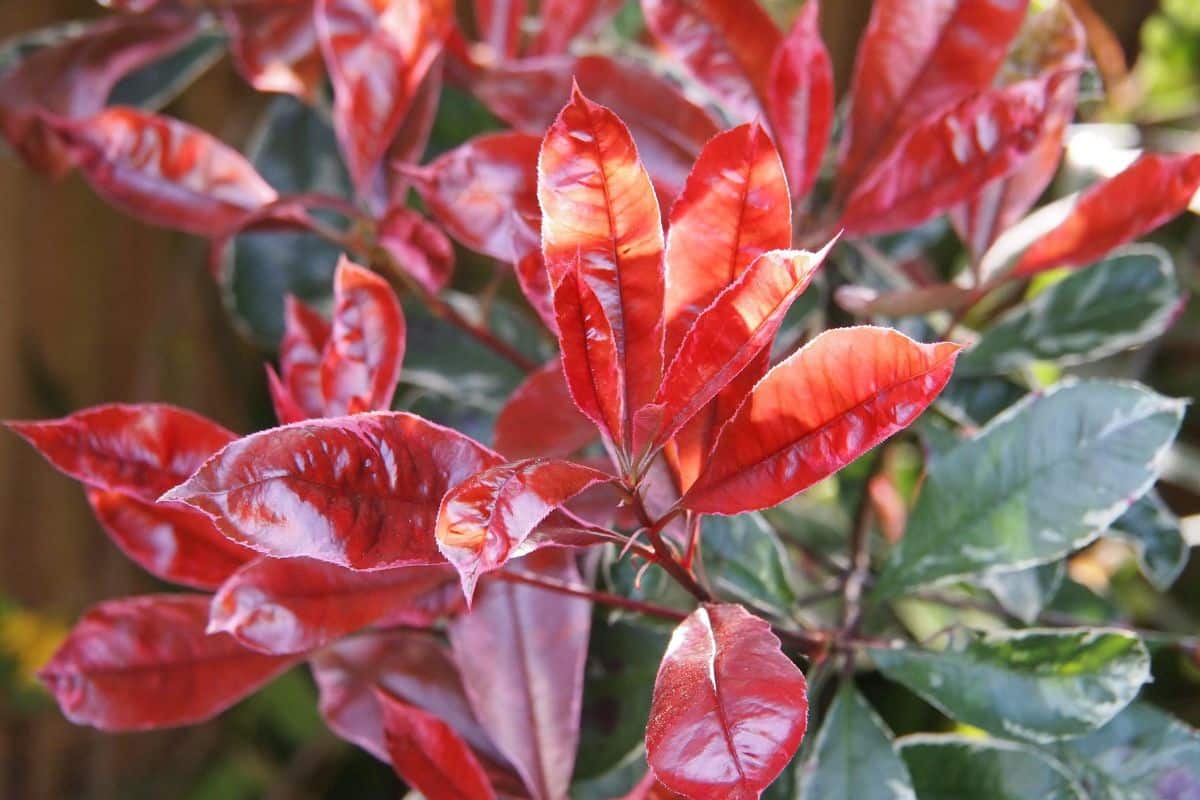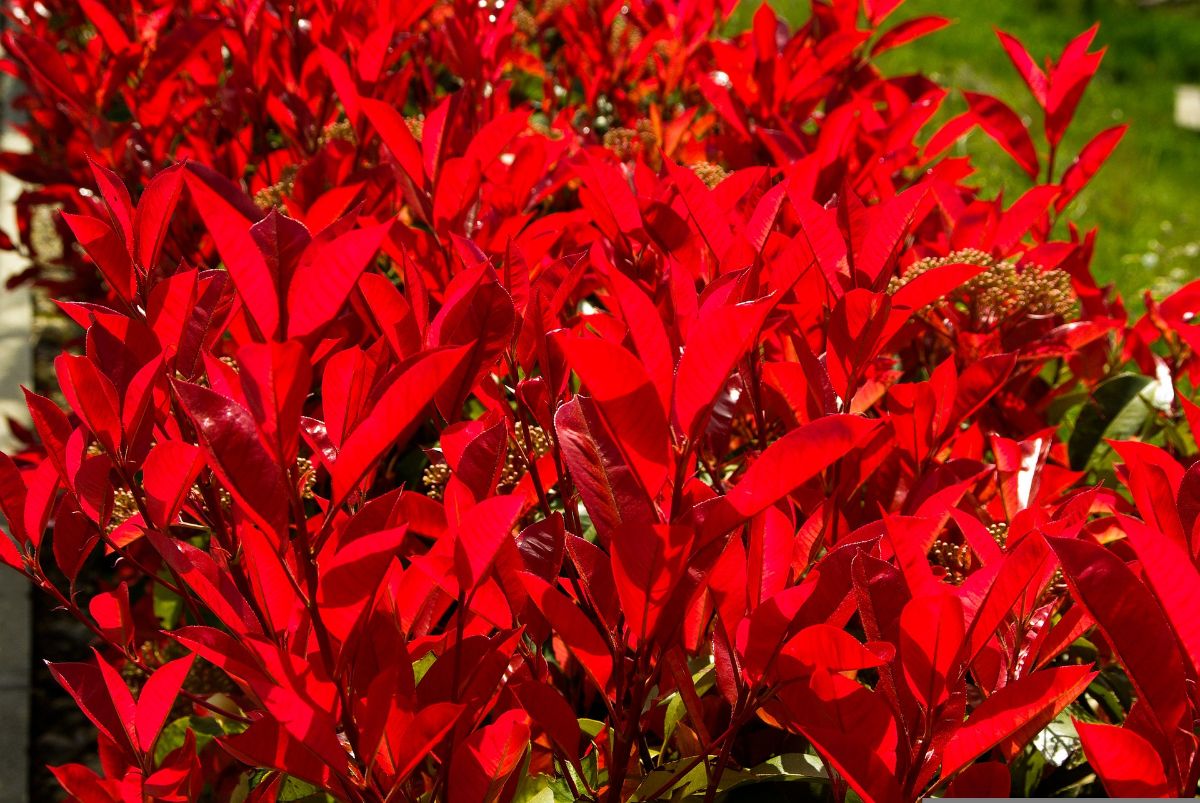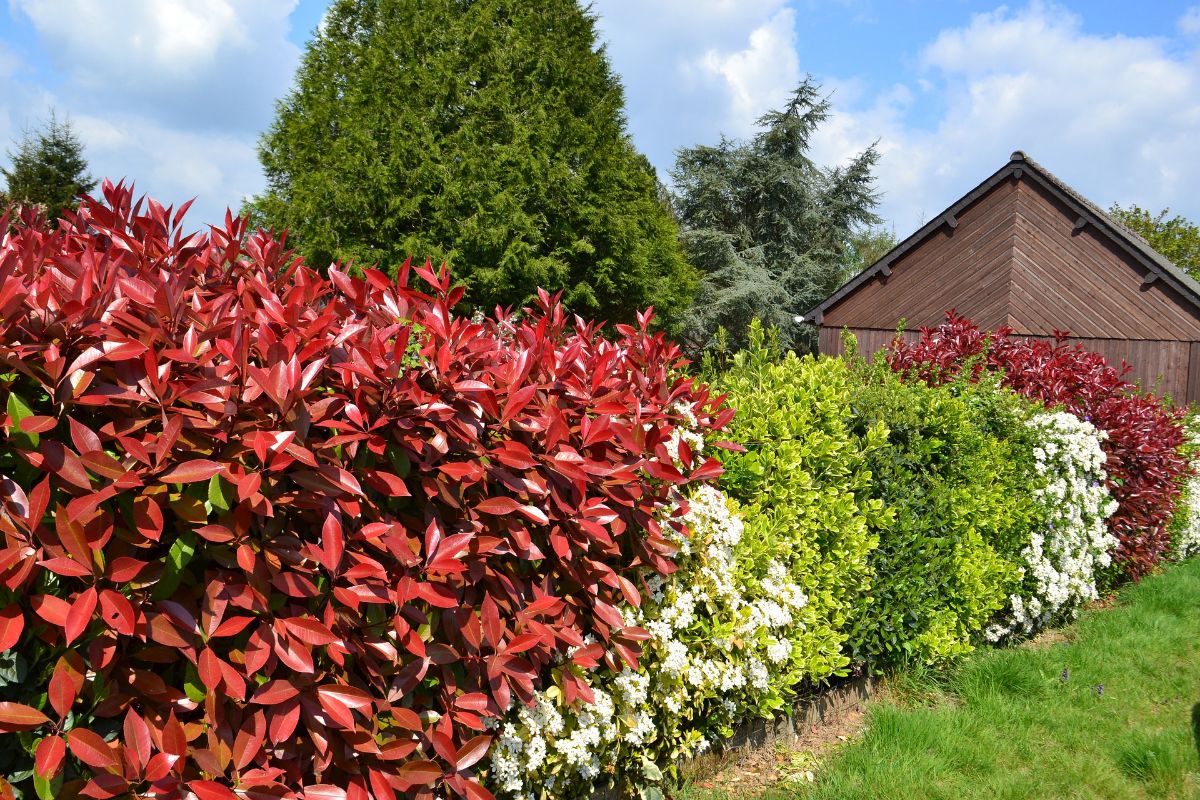
Today we come to talk about one of the most used shrubs for garden decoration. It's about the Photinia fraseri. This plant belongs to the Photinia genus and is the most common and popular specimen of all. It stands out for its great resistance and ease of cultivation. It is a hybrid with red leaves. Next we will go on to analyze in depth this shrub so used by all. We will describe the characteristics, cultivation, reproduction, etc.
If you want to know more about photinia fraseri, I invite you to continue reading 🙂
Key features

Photinia fraseri is commonly known as photinia. Within the genus of this plant are a large number of species of small trees and shrubs. In its varieties we can find evergreen and deciduous trees. In addition, there are several hybrids such as the one we are talking about. This hybrid is the best known of all.
This shrub is evergreen and reaches a height of 3 meters. It grows quite quickly and its cultivation is quite simple. The leaves are elongated and about 10 centimeters in length. They have a consistent and very shiny texture. It is characterized by having a different color depending on the season of the year in which we are. The name is due to the red color that the bracts adopt when they sprout.
Photinia fraseri has small white leaves that bloom when spring arrives. They are grouped in bouquets of 10 flowers. Its use is mainly ornamental. Today it can be seen forming large colorful hedges.
Photinia fraseri care for cultivation
This shrub, like the rest of plant species, requires certain conditions and care so that they can be planted correctly and development is optimal. Although this plant is very easy to grow, it is not free from needing climatic conditions, watering and pruning to survive well.
Next we are going to analyze step by step in a detailed way what are all the necessary requirements for its cultivation.
Temperature and light

These are two conditioning factors for all kinds of plant species. Being a plant native to the temperate zones of Asia, it does not support high temperatures from other regions or extreme cold. It is capable of withstanding some frosts, although not for a long time. It is recommended to plant it in places where the average temperature is around 10 degrees minimum and 18 degrees maximum.
Light is another aspect to take into account for the process of photosynthesis and its growth. It can be grown both in full sun and in areas where there is shade at some times of the day. It does not survive in areas with absolute shade. It is important to select an area for its cultivation where it is sheltered from the wind, since it does not tolerate it.
Soil and irrigation
Photinia fraseri is not a very demanding plant when it comes to the soil where it is grown. However, it is true that it is better to place them on well-drained, fertile land that is rich in nutrients. It is advisable to supply it from time to time with an organic mineral fertilizer. In this way we will get the bush to grow better and more vigorously.
Irrigation will depend on rainfall and weather conditions. If the place where it is grown is very humid, it is better to reduce the frequency of watering. If, on the other hand, rainfall is low and the environment dry, irrigation will have to be increased more. In general, photinia fraseri does not need abundant and frequent watering.
For example, if it is summer and the bush is planted in the ground, simply water it two or three times a week. However, if it is in a pot, the waterings will have to be more repeated. In winter the irrigations decrease considerably.
Where to plant photinia
It is normal that the objective that you have with this plant is that it grows fast and that it gives you a beautiful vision with its reddish leaves. But for this, not only is it enough to choose a good substrate, but the place where you plant it is also important.
In this case, our recommendation is that you do Always in places with full sun. The more sun it has, the better, because it will make the colors of the plant more intense and that will allow you to have a much more beautiful bush. However, it is not the same to plant it in the north of Spain than in the south. And the same would happen in other continents. Because? Well, because when the weather is too hot (for example, summers in the south of Spain) the plant can suffer, and the leaves can burn irreparably. In these cases, it is best to put it in a partially shaded area, to make sure it does not have burns on the leaves.
In short, and from what we have told you, you must take into account, above all, the climate of the area. If you live in a place where the climate is mild all year, put it in full sun. But if it turns out that the summers are unbearable, then it is better in semi-shade.
Another point to take into account is the age of the plant. A small or young girl that you have just bought needs to adapt to her new environment, and that implies that you must provide her with a suitable place for a few months. Little by little you will be able to place it in its fixed place, but that adaptation makes the difference between surviving and dying on you.
Pruning and maintenance
As we have mentioned before, it not only requires irrigation and a good soil, but also some maintenance. Pruning will depend on whether it has been grown to form hedges or not. If so, maintenance pruning is needed. In winter it is the best time to carry out the most severe pruning, since there is less density of leaves.
It is important to know that if you want to maintain the reddish color of the leaves, you have to prune it often. The buds that are fresh out do not have that pigmentation.
Ideal tools for a good pruning
To efficiently prune our photinia fraseri we must have a good tool. There are some machines that have been designed to facilitate this task. Here are some of them.
- Hedge trimmer 122HD45: It is perfect for carrying out the tasks of maintenance and care of the plants in your garden. With it you will be able to prune the photinia much better.
- 536LiHE3 hedge trimmer: It has a large lithium-ion battery and is suitable for working in residential areas. With this hedge trimmer equipped with a tube, the tallest photinias can be pruned effortlessly.
- 115iHD45 Hedge Trimmer KIT: This kit includes a hedge trimmer with battery and charger. It can be used to prune easier and faster. It has a very low weight and is environmentally responsible.
When to prune photinia fraseri
If you already have a Photinia fraseri, you will have noticed that it is in summer when it grows and develops the most. But When it comes to pruning it, it is not convenient to do it after the summer, but to wait until the beginning of spring. The reason is simple: if you prune it in autumn, its health will suffer, in addition to leaving open wounds that can be the gateway for diseases and pests that will consume it during the winter (and affect its development).
However, you should keep in mind that, if you have just planted or acquired it, it is not recommended that you prune it until you begin to notice that the plant is growing. First of all, he has to adapt to his new environment since, otherwise, he would harm his condition and could even rush to certain death.
How to make a photinia hedge

It is common for fotinias to be used as a hedge to obtain privacy with them. A fence covered with the plant (so that the neighbors do not look) or a panel where the plant has grown to create different spaces in the garden are very common.
And in this case, what will make it possible for you to make a hedge will be pruning.
As you know, Photinia fraseri is a fast growing plant. As long as you provide him with all the needs he has, you will have no problem with him growing. And there you must be prepared.
At the beginning, during the first years you will have to let it grow a little at will, since the objective you have is to cover the greatest possible extension. But once you achieve it (without losing the annual pruning that must be done), it is convenient that you start pruning it more regularly.
Two prunings a year are recommended, one in spring and one in autumn, to maintain an order in the hedge and that it does not lose the shape you want it to acquire. If it is very fast growing, you could opt for a third pruning in the summer, in order to control the growth and make it develop more in the areas that you want compared to others that you do not.
Diseases and pests
Although photinia fraseri is a very resistant shrub and manages to avoid many diseases and pests, it is affected as well. For example, it can be attacked by fungi and other organisms that cause damage to its leaves.
The fungus is the most common disease in photinia. It is caused by a leaf spot that, if not treated in time, can kill all the leaves of the plant and, therefore, kill the entire bush. The spots initially have a dark red color and they end up turning gray when the infection begins to worsen. The disease can spread from leaves to branches and appears with excessive humidity. The times of more humidity are in winter and spring.
To solve this fungal problem, it is best to treat the plant with systemic fungicides.
Specifically, some of the diseases that you should take into account are:
fire blight
This curiously named problem is actually an infection that can kill photinia. The cause of this is a bacterium, the Erwinia anyovora. This, when it affects the plant, makes it the flowers seem soaked in water and also as if they lost their color.
Little by little it is affecting the plant more and more, to the point that the leaves, stems, branches, flowers... will look as if they had been burned.
Do you have a cure? The truth is that yes, with a copper bactericide. But you should remove the branches or infected parts as soon as possible, and even if there are plants around it, treat them too because it is contagious.
As prevention, if you add a little nitrogen to the soil in autumn or early springMuch better.
venturia inaequalis
This fungus is well known by those who have apple trees, since it is the cause of the so-called 'apple scab'. And, in the case of photinias, it affects them too. Among the damages that you will notice from this fungus are the dark spots on the underside of the leaves which, over time, will resemble lesions on the plant.
To solve it, nothing better than using a product rich in copper to eliminate it and, as prevention, use some fungicide that you will apply several times a year.
Leaf spot
It is very possible that you know it like this, but in reality the experts refer to it as Entomosporium. This is the name given to the fungus that causes this disease and we must tell you that if you do not catch it in time, you run the risk of losing the entire plant.
It is characterized by making the plant present on the leaves small dark red spots. At first they will be scattered, but as the disease progresses, they can gather together and do much more damage. In addition, it can easily spread to the branches, causing moldy spots to appear that precipitate leaf drop more quickly.
The disease affects mainly in the spring months, but also when there is an abundant rainy season.
Fortunately, it has a cure. In fact, when this fungus is detected, the first thing that is recommended is that place the plant in full sun in a place where there are good air currents (but don't affect it too much). It should be isolated from other plants, as they could become infected.
It is also advisable to remove the affected leaves as well as the branches and, if possible, clean the entire plant with a copper-based product or a fungicide (The latter could be used several times a year as prevention). Another option is to use horsetail instead of the fungicide.
green aphid
Among the pests, one of the ones that will affect you the most is the green aphid. This directly attacks the tender shoots, and they must be protected as it could compromise the health and growth of the plant.
To fix it, it's best to use Potassium soap with Neem oil at the first signs.
I hope that with these tips you can take care of your photinia perfectly.
incredible… you put a video in English. Well, it seems very bad to me, we are in Spain ...
Hi John.
The blog is made from Spain and the majority of readers are residents of this country, but actually they visit us from all over the world.
Regarding the language of the video, it is true that it would be better if it were in Spanish, but sometimes it is difficult for us to find videos on the subject we are looking for in that language.
Greetings.
I have a Pothinia and a bug is eating it, it has holes in the leaves and others seem bitten because they are missing a piece. What can be?
Hello M. Angeles.
It could be that some caterpillar or larva is eating them, or even some snail.
I recommend you carefully inspect the plant: branches, leaves, trunk, to see if the insect appears. Some larvae and caterpillars can go unnoticed, so if you have a magnifying glass, use it because it can be very useful. I think you can also use your mobile as a magnifying glass, downloading an application from the Play Store or Apple Store, depending on the type of device you have.
In any case, a highly effective natural remedy is diatomaceous earth (you can buy it here). It is a very light white powder made of algae that, as soon as it comes into contact with the body of the insect, pierces it causing it to die of dehydration.
Regards!
I have Pothinia in a planter in a community of flats. Do you know if the roots can cause breakage of the structure or if the roots are not so aggressive?
Hi Evan.
No, photinias do not have problematic roots. Do not worry.
Greetings.
Hello, I transplanted three plants continuously, and one has brown leaves, with new shoots, but the leaves keep turning like this, how can I recover it?
Hi Rominia.
The roots may have suffered a bit with the transplant. My advice is that you water them twice a week, or three if it is very hot (temperatures of 30 degrees or more).
If they are in pots, and you have put a plate under them, drain it after each watering.
Greetings.
Hello, After having planted a Photinia Fraser red robin hedge in a palisade, some subjects began to wilt despite being planted by a landscaper. Some bushes showed signs of weakness after 2 months and others wilted quickly after creating many new shoots. Some leaves on some plants have turned bright red and are turning brown in the center, and appear to be drooping profusely. I am distraught because I fear that many subjects will die in the near future. Also, several shrubs have leaves that wither first and the entire shrub quickly follows. They look completely dead. I am in a temperate region and followed the watering instructions for the first few months. Can you help me not to lose anymore? Thank you very much
Hi Mike.
When planting a plant, whatever it is, it is very important not to manipulate its roots too much, otherwise it will later cost more to resume its growth.
But also, you have to take into account the location in which they were before planting. And it is that if they were in the shade and then they are planted in direct sun, they will burn because they will not be used to it.
Also, it is very important that they do not water too often. The fotinia need about 2 or 3 irrigations a week during the summer, 1-2 a week the rest of the year. When they are watered, the soil must be wetted, never the leaves except if at that time the sun no longer shines on them, in which case it would be interesting during the summer.
So, my advice is to cut off the dry parts, and to control the watering. If you happen to have them near or next to the lawn, remove it so the roots don't stay wet for so long.
Regards!
what would be the diameter, or how many meters, for a fence you have to raise it?
Hello Beatriz.
More or less, there must be about 40 centimeters between one plant and another.
Greetings.